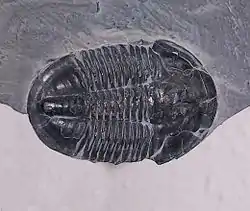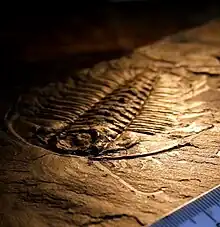| Wheeler Shale | |
|---|---|
| Stratigraphic range: Middle Cambrian ~ | |
 Elrathia kingii, famed trilobite of the Wheeler Shale. | |
| Type | Geological formation |
| Thickness | 100–200 m (330–660 ft) |
| Lithology | |
| Primary | Calcareous shale |
| Other | Mudstone, shaley limestone and limestone |
| Location | |
| Coordinates | 39°15′N 113°20′W / 39.25°N 113.33°W |
| Region | House Range and Drum Mountains, Millard Co., west Utah |
| Country | United States |
| Type section | |
| Named for | House Amphitheater (Geographic feature and type locality) |
| Named by | Charles Doolittle Walcott |
| Part of a series on |
| The Cambrian explosion |
|---|
 |
The Wheeler Shale (named by Charles Walcott) is a Cambrian (c. 507 Ma) fossil locality world-famous[1] for prolific agnostid and Elrathia kingii trilobite remains (even though many areas are barren of fossils)[2] and represents a Konzentrat-Lagerstätte. Varied soft bodied organisms are locally preserved, a fauna (including Naraoia, Wiwaxia and Hallucigenia) and preservation style (carbonaceous film) normally associated with the more famous Burgess Shale.[3] As such, the Wheeler Shale also represents a Konservat-Lagerstätten.[4]
Together with the Marjum Formation and lower Weeks Formation, the Wheeler Shale forms 490 to 610 m (1,610 to 2,000 ft) of limestone and shale exposed in one of the thickest, most fossiliferous and best exposed sequences of Middle Cambrian rocks in North America.[5]
At the type locality of Wheeler Amphitheater, House Range, Millard County, western Utah, the Wheeler Shale consists of a heterogeneous succession of highly calcareous shale, shaley limestone, mudstone and thin, flaggy limestone.[6] The Wheeler Formation (although the Marjum & Weeks Formations are missing) extends into the Drum Mountains, northwest of the House Range where similar fossils and preservation are found.[6]
Taphonomy and sedimentology


Detailed work recognises a number of ~10 m thick lagerstätten sequences in the formation, each of which formed at a sea-level high stand[7] in deep water.[8] The lagerstätte were deposited by turbidities and mudslides onto an oxygenated sea floor.[7] The productive layers comprise mud and clay particles, with a tiny fraction of wind-blown quartz.[9]
Stratigraphy
The Wheeler Shale spans the Ptychagnostus atavus[10] and uppermost-Middle Cambrian Bolaspidella trilobite zones (See House Range for full stratigraphy).
Fauna

Incomplete list of the fauna of the Wheeler Shale:[6][11][12][13][14][15][16] (Note: the preservation of hard bodied trilobite remains and soft bodied animals seems to be mutually exclusive within particular horizons.)[4][17]
Protista
- Marpolia spissa - cyanobacteria or green algae
- Morania fragmenta - cyanobacteria
Arthropoda
- Branchiocaris pretiosa - hymenocarine
- Branchiocaris sp.
- Cambropodus gracilis - possible myriapod
- Canadaspis perfecta - hymenocarine
- Dicerocaris opisthoeces
- Emeraldella brocki - vicissicaudatan
- Isoxys
- Perspicaris dilatus hymenocarine
- Pseudoarctolepis sharpi - possible hymenocarine
- Tuzoia? peterseni hymenocarine
- Waptia fieldensis hymenocarine
- Alalcomenaeus cambricus - megacheiran; or alalcomenaeid
- Dicranocaris guntherorum - megacheiran; or alalcomenaeid
- unnamed 'Molli Sonia symmetrica'
- Leanchoilia superlata - megacheiran
- Sidneyia inexpectans - vicissicaudatan
Dinocaridida
- Amplectobelua cf. A. stephenensis – radiodont[18]
- Anomalocarididae gen. et sp. nov. - radiodont[18]
- Buccaspinea cooperi? - radiodont[18]
- Caryosyntrips durus - radiodont[18]
- Caryosyntrips serratus - radiodont[18]
- Peytoia nathorsti - radiodont[18]
- Pahvantia hastata - radiodont[18]
- Stanleycaris sp. - radiodont[18]
- Utaurora comosa - opabiniid[19]
Trilobita
- Naraoia compacta - naraoiid nectaspid
- Hypagnostus parvifrons - agnostid
- Peronopsis amplaxis - peronopsid agnostid
- Peronopsis bidens
- Peronopsis fallax
- Peronopsis gaspensis
- Peronopsis intermedius
- Peronopsis interstrictus
- Peronopsis montis
- Peronopsis segmentis
- Ptychagnostus atavus (= Acidusus atavus) - ptychagnostid agnostid
- Ptychagnostus germanus
- Ptychagnostus gibbus
- Ptychagnostus intermedius
- Ptychagnostus michaeli
- Ptychagnostus occultatus
- Ptychagnostus seminula
- Glyphaspis concavus - asaphid
- Bathyuriscus fimbriatus - dolichometopid corynexochid
- Bathyuriscus sp.
- Kootenia sp. - dorypygid corynexochid, perhaps a synonym of Olenoides
- Olenoides expansus - dorypygid corynexochid
- Olenoides nevadensis
- Olenoides serratus
- Tonkinella breviceps
- Zacanthoides divergens - zacanthoidid corynexochid
- Zacanthoides sp.
- Altiocculus harrisi - ptychopariid (specific name may be confused with Alokistocare)
- Alokistocare harrisi - alokistocarid ptychopariid
- Asaphiscus wheeleri - ptychopariid; second-most common species in the formation
- Bathyocos housensis - ptychopariid
- Bolaspidella drumensis
- Bolaspidella housensis
- Bolaspidella sp.
- Bolaspidella wellsvillensis
- Brachyaspidion microps
- Brachyaspidion sulcatum
- Cedaria minor - known from the Warrior Formation
- Elrathia kingii - alokistocarid ptychopariid
- Elrathia sp.
- Elrathina wheeleri = Ptychoparella wheeleri? - ptychopariid
- Jenkinsonia varga
- Modocia brevispina
- Modocia laevinucha
- Modocia typicalis
- Ptychoparella sp. - ptychopariid
- Ptychoparella wheeleri
- Spencella sp. - ptychopariid
Brachiopoda
- Acrothele subsidua
Chordata
Cnidaria
- Cambromedusa sp. - jellyfish
Mollusca
Echinodermata
- Castericystis sprinklei - carpoid
- Castericystis sp.
- Cothurnocystis sp. - stylophoran
- Ctenocystis sp. - ctenocystoid
- Gogia spiralis - eocrinoid
- Eocrinoid holdfasts believed to belong to Gogia spiralis; may belong to other species
Porifera
- Choia carteri - choiid monaxonid demosponge
- Choia utahensis
- Crumillospongia sp. - hazeliid monaxonid demosponge
- Diagonella sp.
Priapulida
- Ottoia prolifica - a stem group and it was an archaeopriapulid
- Selkirkia sp. - archaeopriapulid
- "Selkirkia willoughbyi" (Note: S. columbia is the only recognized species)
Unclassified
- Hallucigenia sparsa - ?xenusiid lobopod
- Utahnax vannieri - stem-arthropod lobopod, also possible that is from Marjum Formation[20]
- Allonnia cf. tintinopsis - a chancelloriid[21]
- Chancelloria pentacta - chancelloriid coeloscleritophoran, perhaps a sponge?
- Eldonia sp. - eldoniid paropsonemid cambroernid
- Skeemella clavula - Possible vetulicolian
- Hylolithellus sp. - annelid?
- Wiwaxia corrugata - halwaxiid? lophotrochozoan
- Yuknessia simplex - pterobranch
- Margaretia dorus - possibly organic tube associated with hemichordate[22]
References
- ↑ Johnson, Kirk; Troll, Ray (2007), Cruising the fossil freeway: An epoch tale of a scientist and an artist on the ultimate 5,000-Mile paleo road trip, Golden, CO.: Fulcrum Publishing, ISBN 978-1-55591-451-6
- ↑ Robert R. Gaines; Mary L. Droser (2003), "Paleoecology of the familiar trilobite Elrathia kingii: An early exaerobic zone inhabitant" (PDF), Geology, 31 (11): 941–4, Bibcode:2003Geo....31..941G, doi:10.1130/G19926.1
- ↑ Robert R. Gaines; Derek E.G. Briggs; Zhao Yuanlong (2008), "Cambrian Burgess Shale–type deposits share a common mode of fossilization", Geology, 36 (10): 755–758, Bibcode:2008Geo....36..755G, doi:10.1130/G24961A.1
- 1 2 Gaines, R; Kennedy, M; Droser, M (2005), "A New Hypothesis for Organic Preservation of Burgess Shale Taxa in the Middle Cambrian Wheeler Formation, House Range, Utah", Palaeogeography, Palaeoclimatology, Palaeoecology, 220 (1–2): 193–205, Bibcode:2005PPP...220..193G, doi:10.1016/j.palaeo.2004.07.034
- ↑ Robison, R.A. (1964), "Late Middle Cambrian faunas from western Utah", Journal of Paleontology, 38 (3): 510–566
- 1 2 3 Gunther, L.F.; Gunther, V.G. (1981), "Some Middle Cambrian Fossils of Utah", Brigham Young University Geology Studies, 28: 1–81
- 1 2 Brett, C. E.; Allison, P. A.; Desantis, M. K.; Liddell, W. D.; Kramer, A. (2009). "Sequence stratigraphy, cyclic facies, and lagerstätten in the Middle Cambrian Wheeler and Marjum Formations, Great Basin, Utah". Palaeogeography, Palaeoclimatology, Palaeoecology. 277 (1–2): 9–33. Bibcode:2009PPP...277....9B. doi:10.1016/j.palaeo.2009.02.010.
- ↑ Halgedahl, S. L.; Jarrard, R. D.; Brett, C. E.; Allison, P. A. (2009). "Geophysical and geological signatures of relative sea level change in the upper Wheeler Formation, Drum Mountains, West-Central Utah: A perspective into exceptional preservation of fossils". Palaeogeography, Palaeoclimatology, Palaeoecology. 277 (1–2): 34–56. Bibcode:2009PPP...277...34H. doi:10.1016/j.palaeo.2009.02.011.
- ↑ Gaines, R. R.; Kennedy, M. J.; Droser, M. L. (2005). "A new hypothesis for organic preservation of Burgess Shale taxa in the middle Cambrian Wheeler Formation, House Range, Utah". Palaeogeography, Palaeoclimatology, Palaeoecology. 220 (1–2): 193–205. Bibcode:2005PPP...220..193G. doi:10.1016/j.palaeo.2004.07.034.
- ↑ Lieberman, B. S. (2003). "A New Soft-Bodied Fauna: the Pioche Formation of Nevada". Journal of Paleontology. 77 (4): 674–690. doi:10.1666/0022-3360(2003)077<0674:ANSFTP>2.0.CO;2. ISSN 0022-3360. S2CID 130145927.
- ↑ Briggs, D.E.G.; Robison, R.A. (1984), Exceptionally preserved nontrilobite arthropods and Anomalocaris from the Middle Cambrian of Utah, The Paleontological Institute, The University of Kansas
- ↑ Photos of Wheeler Shale fossils from UC Berkeley
- ↑ Rigby, J.K. (1978), "Porifera of the Middle Cambrian Wheeler Shale, from the Wheeler Amphitheater, House Range, in western Utah", Journal of Paleontology, 52 (6): 1325–1345, JSTOR 1303938
- ↑ Utah's Cambrian Life from University of Kansas Natural History Museum
- ↑ Cambrian fossils from Utah by the University of Utah
- ↑ Comprehensive treatment from The Virtual Fossil Museum
- ↑ Gaines, Robert R.; Droser, Mary L.; Kennedy, Martin J. (2001), "Taphonomy of soft-bodied preservation and ptychopariid Lagerstätte in the Wheeler Shale (Middle Cambrian), House Range, USA; controls and implications", PaleoBios, 21 (Suppl.2): 1–55
- 1 2 3 4 5 6 7 8 Pates, Stephen; Lerosey-Aubril, Rudy; Daley, Allison C.; Kier, Carlo; Bonino, Enrico; Ortega-Hernández, Javier (2021-01-19). "The diverse radiodont fauna from the Marjum Formation of Utah, USA (Cambrian: Drumian)". PeerJ. 9: e10509. doi:10.7717/peerj.10509. ISSN 2167-8359. PMC 7821760. PMID 33552709.
- ↑ Pates, Stephen; Wolfe, Joanna M.; Lerosey-Aubril, Rudy; Daley, Allison C.; Ortega-Hernández, Javier (2022-02-09). "New opabiniid diversifies the weirdest wonders of the euarthropod stem group". Proceedings of the Royal Society B: Biological Sciences. 289 (1968): 20212093. doi:10.1098/rspb.2021.2093. PMC 8826304. PMID 35135344.
- ↑ Lerosey‐Aubril, Rudy; Ortega‐Hernández, Javier (2022). Zhang, Xi‐Guang (ed.). "A new lobopodian from the middle Cambrian of Utah: did swimming body flaps convergently evolve in stem‐group arthropods?". Papers in Palaeontology. 8 (3). doi:10.1002/spp2.1450. ISSN 2056-2799. S2CID 250076505.
- ↑ Foster, John R.; Howells, Thomas F.; Sroka, Steven D. (2022). "First record of the chancelloriid Allonnia from the middle Cambrian Wheeler Formation (Drumian, Miaolingian) of western Utah". PaleoBios. 39 (4). doi:10.5070/P939455661. ISSN 0031-0298. S2CID 251544727.
- ↑ Nanglu, Karma; Caron, Jean-Bernard; Conway Morris, Simon; Cameron, Christopher B. (2016-07-07). "Cambrian suspension-feeding tubicolous hemichordates". BMC Biology. 14: 56. doi:10.1186/s12915-016-0271-4. ISSN 1741-7007. PMC 4936055. PMID 27383414.
